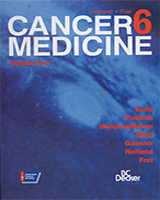By agreement with the publisher, this book is accessible by the search feature, but cannot be browsed.
NCBI Bookshelf. A service of the National Library of Medicine, National Institutes of Health.
Kufe DW, Pollock RE, Weichselbaum RR, et al., editors. Holland-Frei Cancer Medicine. 6th edition. Hamilton (ON): BC Decker; 2003.

Holland-Frei Cancer Medicine. 6th edition.
Show detailsThe treatments for cancer diagnosed during childhood or adolescence have become increasingly successful. Prior to the mid-1960s, many forms of childhood cancer were uniformly fatal. Approximately two-thirds of all children with cancer will now survive for at least 5 years following diagnosis, with most surviving continuously free of disease into adulthood.1
The number of survivors of childhood cancer in the United States population was estimated to be 125,000 in 1990, or approximately 1 in 1,000 persons between the ages of 15 and 45 years.2 Adverse effects of treatment on organ function may influence career and lifestyle choices. Frequently these former patients continue their medical follow-up through their pediatrician, internist, or obstetrician, and direct their questions to these professionals. This chapter reviews the reported research in these areas.
Contents
- Central Nervous System
- Vision
- Hearing
- Teeth
- Salivary Glands
- The Heart
- Lungs
- Kidneys
- The Bladder
- the Liver
- The Intestine
- Musculoskeletal System
- Endocrine System
- Second Malignant Tumors
- References
- Late Effects of Treatment of Cancer in Children and Adolescents - Holland-Frei C...Late Effects of Treatment of Cancer in Children and Adolescents - Holland-Frei Cancer Medicine
Your browsing activity is empty.
Activity recording is turned off.
See more...